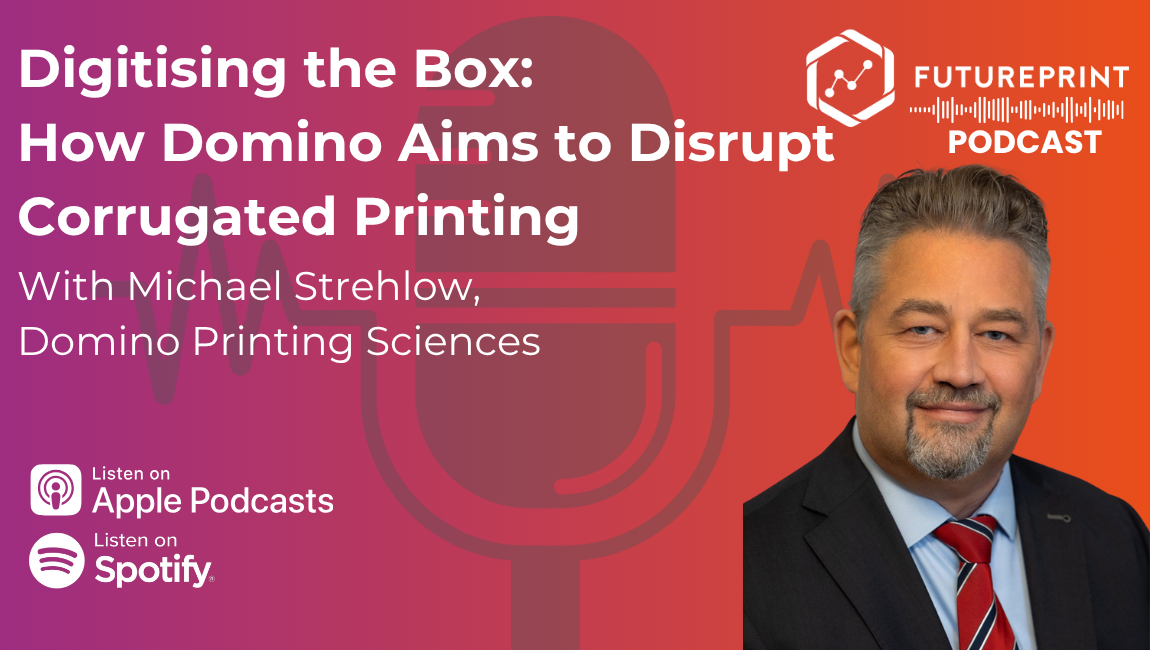Digitising the Box: How Domino Aims to Disrupt Corrugated Printing
For an industry often described as conservative and cautious, corrugated packaging is quietly undergoing a digital awakening. And at the heart of this transformation is Domino Printing Sciences. With the backing of Japanese tech titan Brother Group and an R&D heritage stretching back to 1978, Domino is going big on a sector long primed for disruption but still hesitant to shift gears.
Michael Strehlow, Domino’s newly appointed Account Manager for Corrugated across EMEA, brings with him a career spanning nearly four decades in print and packaging technology. Speaking on the FuturePrint podcast, Strehlow painted a picture of a sector in flux—consolidating, cost-conscious and seeking new efficiencies—yet still largely dependent on analogue workflows. “Digital removes complexity,” he said plainly. “The challenge is helping converters recognise where it actually adds value.”
A Veteran at the Vanguard
Strehlow’s journey into print technology began in 1986, in the heyday of Macintosh and PageMaker. From installing Apple systems in design studios to steering prepress workflow innovation at Heidelberg, he’s seen the print world evolve from pixels to plates—and now to inkjet. His CV includes stints at Konica Minolta, Esko, Kongsberg, and Heidelberg, each step keeping him close to the sharp edge of innovation.
Now, his mission at Domino is to unlock the full potential of the company’s X630i—a single-pass, water-based inkjet press designed specifically for corrugated packaging. “It’s not just about sales,” he explained. “It’s about training teams, creating sample prints, running virtual demos, and showing—hands-on—what this amazing technology can do.”
Boxes and Bottlenecks
At first glance, the corrugated market may not seem glamorous, but its economic and environmental importance is hard to overstate. With e-commerce still booming and retail demanding ever-shorter runs and quicker turnarounds, the pressure on box converters is intense. Yet many continue to rely on flexographic printing, with its long setup times and plate costs.
Add to this a post-pandemic hangover of overcapacity and falling prices, and the market appears ripe for reinvention. “We’re seeing major consolidation,” Strehlow noted. From Seike’s acquisition of Schumacher’s Polish plants to Smurfit Kappa’s merger with WestRock, large players are moving aggressively to expand their footprints. But amid the M&A frenzy lies an opportunity for nimble digital adopters.
The X630i, Strehlow argues, fits this moment. Designed to produce short to mid-run volumes efficiently, it eliminates plates, reduces waste, and enables late-stage customisation. “If your jobs are between 1 and 50,000 units, digital can be faster and more cost-effective,” he said. “But converters must assess their job mix carefully. It’s not about replacing flexo—it’s about finding the digital sweet spot.”
Geography as Destiny
Strehlow’s remit spans Europe, the Middle East, and Africa—regions with divergent market dynamics. Germany leads the continent in corrugated output, followed by Italy and Spain, but smaller markets like Turkey and South Africa show exciting growth and appetite for innovation.
“South Africa has a well-developed packaging sector,” he explained, citing players like Mpact and Boxmore. Meanwhile, Saudi Arabia and the UAE are investing heavily in new plants and tech-forward facilities, driven by optimism and capital. “Middle Eastern markets are less risk-averse than Europe right now,” Strehlow observed. “They’re building from scratch, so they’re far more open to new ideas.”
This strategic openness extends to environmental priorities. While Europe wrestles with regulation and cost pressures, Gulf states are positioning themselves as green manufacturing hubs. That’s good news for Domino, whose water-based inks and closed-loop cartridge systems support a cleaner production model.
Sustainability as Strategy
Domino, through its parent Brother Group, has committed to carbon neutrality by 2050, with interim targets of a 65% reduction in Scope 1 and 2 emissions by 2030. Between 2015 and 2022, the company already slashed those emissions by 44%. It’s also piloting plant-based inks and circular production models. “Sustainability isn’t just a trend,” said Strehlow. “It’s a core driver for innovation.”
This vision aligns with Domino’s partnership with FuturePrint’s ‘Manifesto for More Sustainable Print’, positioning the company as a vocal proponent of environmental responsibility within industrial print. In a category like corrugated—arguably the ‘greenest’ packaging format—sustainability is both a selling point and a source of scrutiny. “Too many boxes are oversized, filled with plastic to compensate,” Strehlow lamented. “The issue isn’t the print—it’s the die cutting.”
That bottleneck remains a challenge. Strehlow, drawing on his experience at Esko, acknowledges the limitations of current digital die-cutting options. With innovators like Highcon having exited the space, the dream of a fully digital box production line remains elusive. “You can print anything digitally,” he said. “But you can’t necessarily cut it easily.”
The Conservative Shift
Digital print's technical advantages are well known. No plates, instant make ready, on-demand customisation. Yet the corrugated industry’s adoption curve remains shallow. Why? Strehlow points to culture. “Converters have systems that work,” he said. “Why disrupt them?”
The answer, as always, is commercial imperative. Brands demand agility. Retailers want versioning. Supply chains need responsiveness. “Nokia dominated mobile until it didn’t. Who’s to say the leaders in the corrugated sector today will still lead in ten years?”
The Road Ahead
Though the X630i is too large to truck into trade shows—at 28 tonnes and 23 metres long—it will be represented in force across upcoming events. Domino is stepping up its industry presence through partnerships with the Sheet Plant Association, FEFCO, and GIFCO, as well as shows like FachPack in Nuremberg, LabelExpo in Barcelona, and Propaper in Dubai.
Even without the hardware, Domino aims to showcase real-world value with print samples, component displays, and on-site demos. “It’s about starting conversations,” Strehlow said. “Digital isn’t a technology pitch—it’s a business solution.”
For now, Domino remains a compelling challenger brand in corrugated. But with decades of inkjet experience, in-house manufacturing, and a clear sustainability narrative, it may not stay that way for long. “We’re not just here to sell machines,” Strehlow concluded. “We’re here to change mindsets.”

